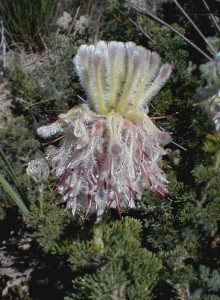
Home
Mission
Overview of Project
Project Staff
Sponsors
Achievements
Checking, Illustrations
Upcoming Activities
Id and Species Lists
Protea Information
Protea Gallery
Growing Proteas
Interim Dist. Maps
Publications
Afrikaanse Inligting
![]()
Se scoparia - 200 year rediscovery
 At a joint excursion between
our midweek Protea Atlas team, the Botanical Society of South Africa, and scientists from
the Compton and Bolus herbaria, we discovered a "new" species in the sandy flats
just north of Hermon. There is no doubt that this species is similar to the Silverpaw
Spiderhead Se incrassata. John Rourke did the preliminary identification and
decided that it resembled the Larkspur-leaf Spiderhead Se delphiniifolia.
This is one of James Niven’s many legacies - he collected it on the dry ascents of
mountains near Paarl, probably around 1800-1805. It was described by Richard Salisbury in
1809 and apparently never heard of again. The first flowering specimens were found by
Terry Trinder Smith (Bolus Herbarium) in Ismail Ebrahim's Protea Atlas Plot - while
participating in the Cape Lowlands Project run by the Botanical Society of South Africa's
Cape Conservation Unit - were from a population of around 20 plants.
At a joint excursion between
our midweek Protea Atlas team, the Botanical Society of South Africa, and scientists from
the Compton and Bolus herbaria, we discovered a "new" species in the sandy flats
just north of Hermon. There is no doubt that this species is similar to the Silverpaw
Spiderhead Se incrassata. John Rourke did the preliminary identification and
decided that it resembled the Larkspur-leaf Spiderhead Se delphiniifolia.
This is one of James Niven’s many legacies - he collected it on the dry ascents of
mountains near Paarl, probably around 1800-1805. It was described by Richard Salisbury in
1809 and apparently never heard of again. The first flowering specimens were found by
Terry Trinder Smith (Bolus Herbarium) in Ismail Ebrahim's Protea Atlas Plot - while
participating in the Cape Lowlands Project run by the Botanical Society of South Africa's
Cape Conservation Unit - were from a population of around 20 plants.
Perusal of our atlas records, shows that a species identified as Se incr, but not in flower, was atlassed by Ruth Smart twice on 27 July in 2000, east of Riebeek West 1997. One population contained one plant and the other – on the railway verge - three! The area also contains the rare Short-leaf Spiderhead Se roxburghii.
On 02 October 2000 John Rourke visited the site and looked at the plants. From this he concluded that the plants were not Se delphiniifolia (which is much more similar to Se incr), but another species the Broom Spiderhead Se scoparia. The differences are subtle, but essentially Se scop has straight, not strongly curved, styles, and spreading, not flat, hairs on the petals. The plants have yellowish, rather than silver, petals as well.
scoparia was described by Robert Brown in 1810, and has not been recorded since. It is also a Niven specimen, collected on the farm La Fontaine – the same locality on which Ruth recorded it. Given these surprises, we decided to revisit Ruth’s localities and also other atlas records of Se incr north of Riebeeck West. Unfortunately, only one of Ruth’s three plants is still alive. Due to time constraints, we were unable to relocate the plants originally seen by Riaan van der Walt (a Nature Conservation officer, and atlasser, from Porterville) and reatlassed by David Louw and Tony Rebelo. However, we did get to see the Se ncr atlassed by David Louw at Goudmynsberg near Moorreesburg. Low and behold, it was the same. More silver, smaller in habit, but identical in flower and inflorescence structure to Se scoparia. It is most unusual for species to occur on such widely different geologies – almost all our other proteas either occur on sand or clay, very few occur on both. Could they be separate species - I would not like to have to try and find a difference between the shale and deep sand forms of this taxon.Serruria scoparia
has been atlassed 11 times during the Protea Atlas Project (all as Se incr as it was never seen in flower). It appears as if this plant is very close to extinction. It is known from seven localities over quite a wide area, but only three of these has more than 20 plants. It survives fires by resprouting from an underground rootstock. It’s mistake is liking soil that is suitable for grapes, and it must be considered as critically Endangered.We still need flowering material (September-October) of the Broom Spiderhead from Leliedam, please.
Have a look at more about Forlorn Spiderhead - Serruria scoparia.
Tony Rebelo
Back PAN 53
